Why you can trust Tom's Hardware
To adjust grayscale tracking, the AW2521H must be set to its Custom Color picture mode. That’s where we did all our testing and calibration.
Grayscale & Gamma Tracking
We describe our grayscale and gamma tests in detail here.
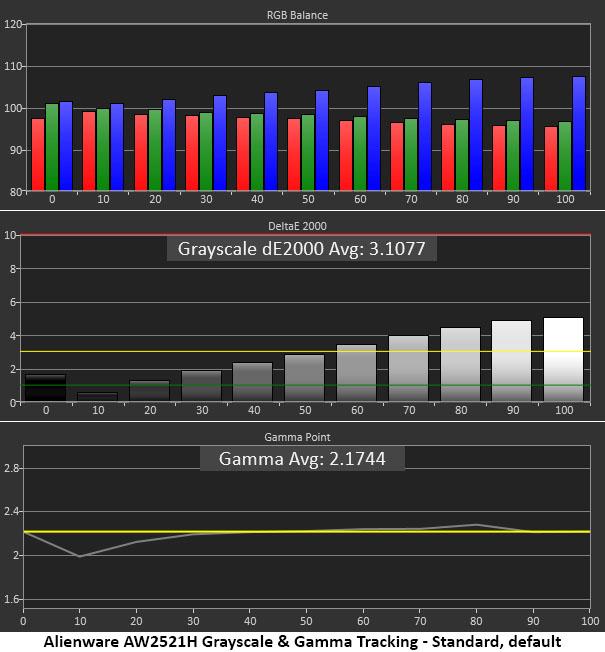
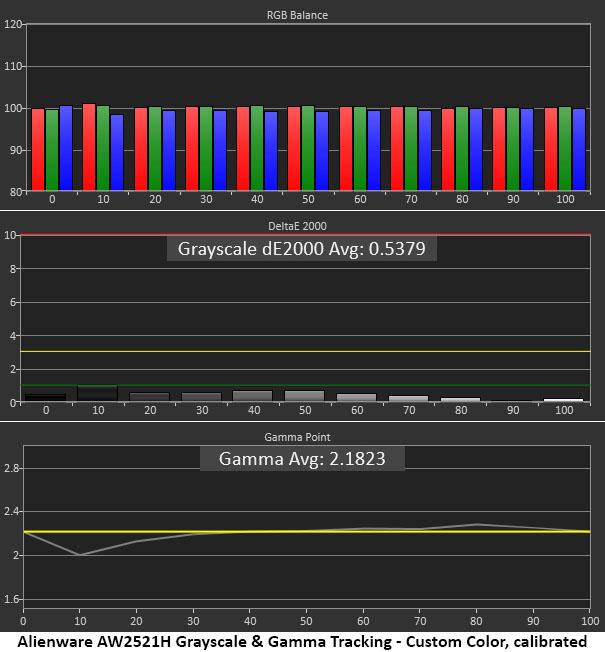
The AW2521H is just a tad too bluE to make our Calibration Not Required list. You can see the error at 60% brightness and above. It isn’t a huge issue, but reducing the blue slider adds image depth and makes overall color truer. Default gamma is close to the 2.2 line except for the 10% step, where it’s a little light. That will make shadow detail a little easier to see but a tad less foreboding.
Adjusting the RGB sliders (in our case, just green and blue), took grayscale tracking to an extremely accurate level with all errors under 1 Delta E (dE). Gamma didn’t change and tracks tightly at all brightness levels except 10%. Custom Color mode is the best option for optimal image fidelity.
Comparisons
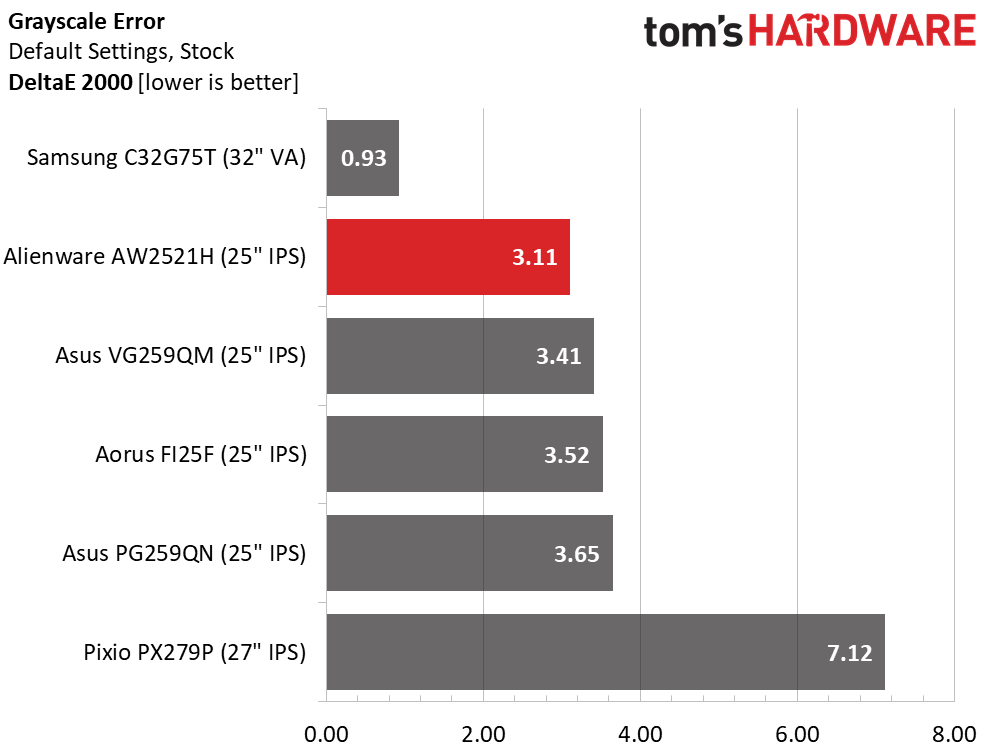
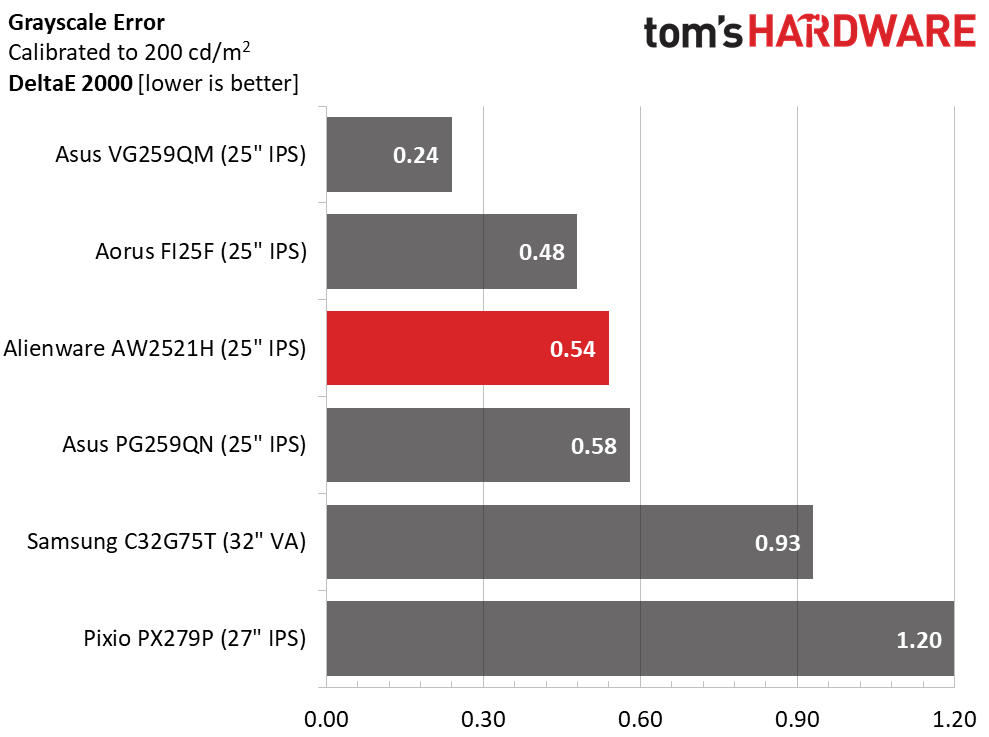
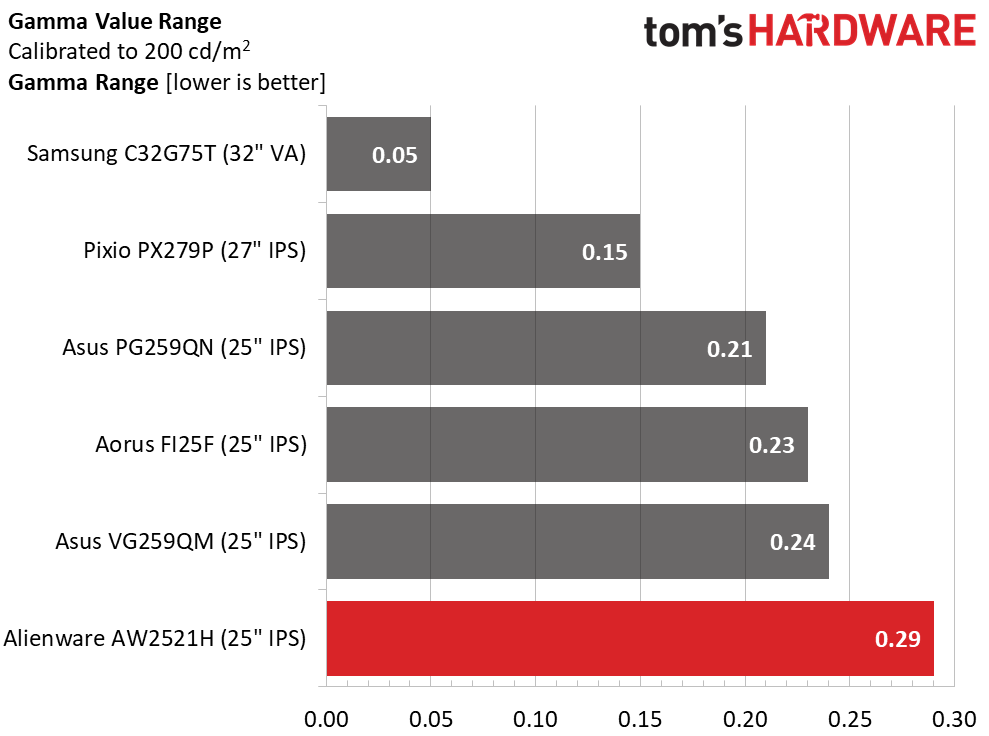
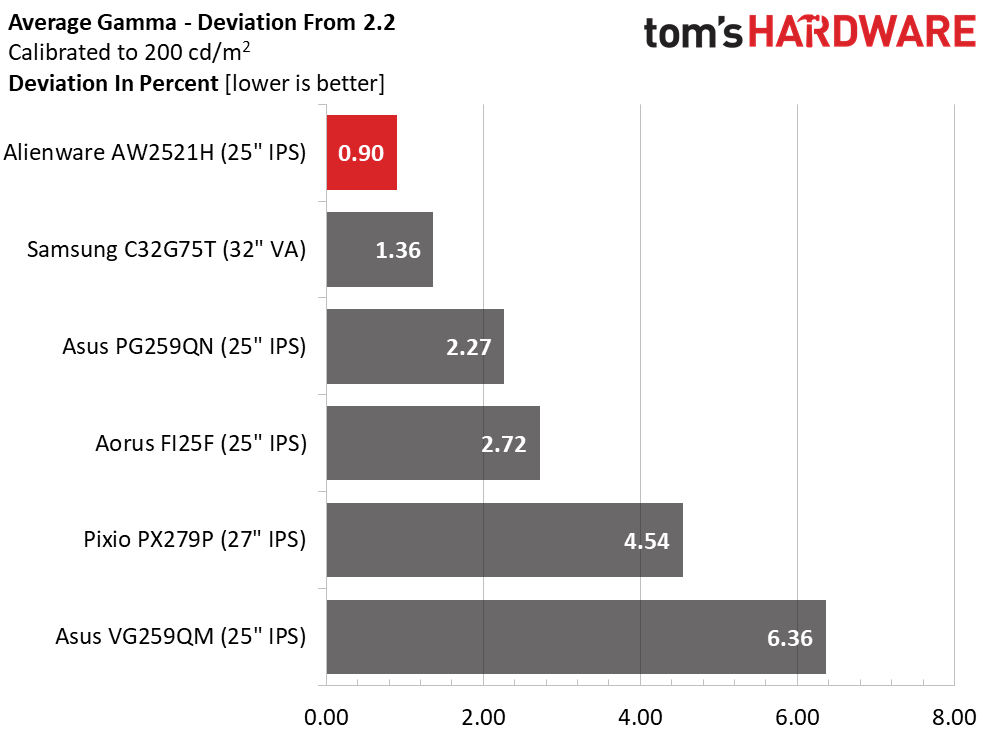
An out-of-box grayscale error 3.11dE is good in this group of monitors, where all but one should be calibrated. The AW2521H benefits greatly from calibration, rising to third place with an impressive 0.54dE score.
The AW2521H’s gamma tracking is a mixed bag. It places last in the range of values, though 0.29 is a solid score. And since every step but 10% is right on the 2.2 line, the average value is 2.18, closer than that of the other monitors here. Ultimately, the Alienware’s gamma is good and contributes to better perceived contrast and color saturation.
Color Gamut Accuracy
For details on our color gamut testing and volume calculations, click here.
Get Tom's Hardware's best news and in-depth reviews, straight to your inbox.
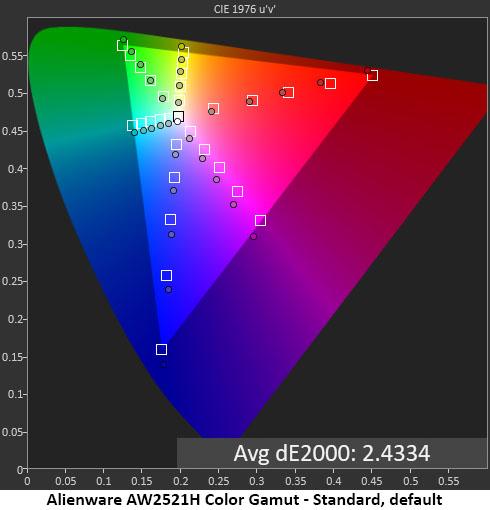
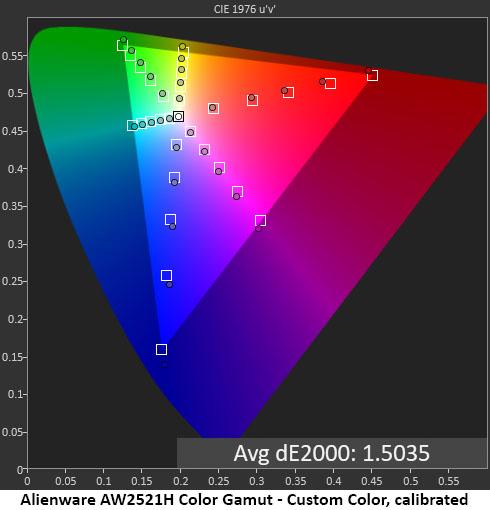
The AW2521H is an sRGB-native monitor with a little bonus volume. Out of the box (first chart) all three primaries are a little outside the perimeter of the sRGB gamut triangle. This contributes to greater saturation for both SDR and HDR content. Red is slightly undersaturated, but all other inner targets are a little over-saturated. The good news is this isn’t noticeable in real-world content. The blue white point in the center pulls magenta and cyan off hue, but we were able to fix this with our grayscale calibration.
Our RGB adjustments (second chart) removed the secondary color errors. 60 and 80% red are still slightly under-saturated, but this is not a visible error. You’re looking at excellent performance.
Comparisons
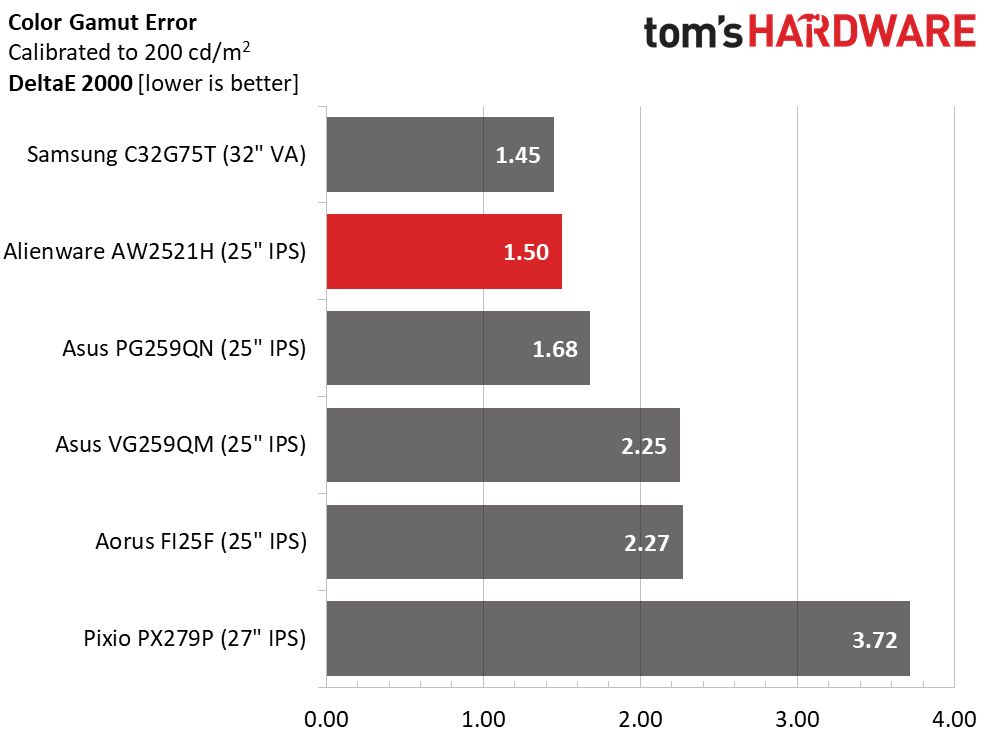
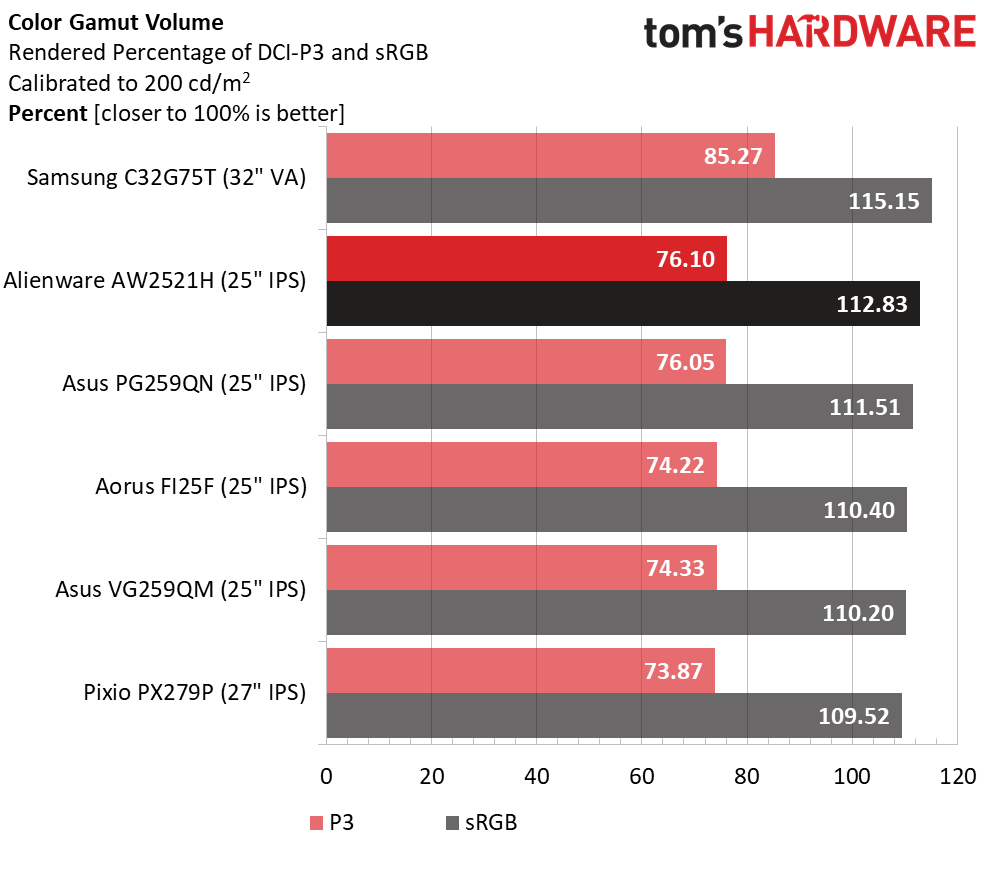
The AW2521H’s default color error is 2.43dE, which is nothing to complain about, since errors under 3dE are typically considered invisible to the naked eye. Our calibration took that number down to 1.50dE, even better. Though there is no attempt at DCI-P3 color here, saturation is vivid and bright for both SDR and HDR material.
If you want a DCI-P3 monitor that runs fast, the Samsung is one of the few choices out there. It covers over 85% of the color space and has an sRGB mode that covers over 115% of sRGB. But the Alienware comes in second place with 112.83% for sRGB. This is a good compromise, considering its speed advantage over almost every monitor in existence. The 360 Hz PG259QN is only a tiny bit behind with 111.51% of sRGB. And all the screens here are very colorful, they just don’t all cover DCI-P3.
Current page: Grayscale, Gamma and Color
Prev Page Brightness and Contrast Next Page HDR Performance
Christian Eberle is a Contributing Editor for Tom's Hardware US. He's a veteran reviewer of A/V equipment, specializing in monitors. Christian began his obsession with tech when he built his first PC in 1991, a 286 running DOS 3.0 at a blazing 12MHz. In 2006, he undertook training from the Imaging Science Foundation in video calibration and testing and thus started a passion for precise imaging that persists to this day. He is also a professional musician with a degree from the New England Conservatory as a classical bassoonist which he used to good effect as a performer with the West Point Army Band from 1987 to 2013. He enjoys watching movies and listening to high-end audio in his custom-built home theater and can be seen riding trails near his home on a race-ready ICE VTX recumbent trike. Christian enjoys the endless summer in Florida where he lives with his wife and Chihuahua and plays with orchestras around the state.
-
barryv88 Stopped readying when I saw it was only HD.Reply
HD is waaaaay past is selling date. Who still wants to buy a monitor in this day and STILL be stuck for HD for many years to come?
This is also in conflict with Tom's recommending the world sweet spot res which is QHD. Move on already people. -
BX4096 High refresh rates is the most overhyped gimmick feature I've seen in all my life spent in computing. A 1080p 25-incher for $800? My god, some people are dumb...Reply -
gaborbarla HighReply
BX4096 said:High refresh rates is the most overhyped gimmick feature I've seen in all my life spent in computing. A 1080p 25-incher for $800? My god, some people are dumb...
Why would high refresh rates be a gimmick? I am a gamer with some competitive gaming background and I can tell you that high refresh rate makes a huge difference both in smoothness of scrolling and actual ease of aiming on FPS games. The usefulness diminishes as we go over 144Hz, but a blur remains, which this monitor supposedly reduces as much as possible. On https://www.testufo.com/ my 144Hz 1440p monitor shows a clear and very visible advantage over 60Hz. With regards to the 1080p, I agree that it is not for me either, but some of the best gamers in the world still use 1080p higher refresh monitors with 240Hz+ and the reason for this is because they can play better with them than a higher res lower refresh monitor, as simple as that. 1080p provides manufacturers a lower amount of pixels to be processed so they can push the price down to acceptable levels. That same monitor probably would not be possible on 1440p or would get crazy expensive as they have to string together processors to pump so many pixels out. -
gaborbarla Replyteknic111 said:Can the human eye see such things?
Over 144Hz it becomes more a feeling than seeing. Also I think this monitor is more than just Hz as reducing blur is just as much about pixel response as high Hz. You get very some bad 144Hz monitors compared to very good ones. -
eklipz330 if you have to ask who this is for, it's not for you.Reply
just how professional athletes are capable of super human feats, their footwear and attire matters just so they can shave off milliseconds.
the same applies to professional gamers. they are extremely good at what they do, and one shouldn't confuse someone who is good at games that plays on their down time versus those who do it professionally for a living. their entire day revolves around sharpening their skills, just like an athlete. so the mouse they use, the keyboard they use, the monitor all matters. resolution isn't as important to them, and there is an optimal screen size so their eyes move less. all professional gamers turn down all graphics and effects to maximize framerate and minimize any on screen distraction. this isn't for immersion. it's for a practical use to shave off milliseconds.
again, not for you. -
s997863 ReplyThe reduction in motion blur is visible, and the response is addictive. You won’t care that the resolution is FHD
This sounds like my reason for still using a CRT to play old games on my i7 PC at 800x600 or 640x480, except those are running only at 60Hz or 85Hz at most. Can somebody please compare this monitor to CRTs for blurring / ghosting in full-screen scrolling? -
Endymio Reply
I'd love to see a double-blind study on high-refresh monitors. I'd bet a sizeable sum that 90%+ of people can't distinguish anything above 120hz.BX4096 said:High refresh rates is the most overhyped gimmick feature I've seen in all my life spent in computing. A 1080p 25-incher for $800? My god, some people are dumb...
I'd also like to point out for the math-challenged here that a monitor with a 3ms response time can't quite hit 360 hz. So there's either some rounding or fudging going on. -
fevanson I have a Viewsonic 144hz VA panel, and I bought it for the great contrast ratio, as dealing with HDR is a hit or miss on Windows 10. Although there is slight blur due to it being a "cheaper" panel, the black detail is amazing for not even having hdr. I guess the 80,000,000:1 dynamic contrast ratio really works well on this monitor.Reply